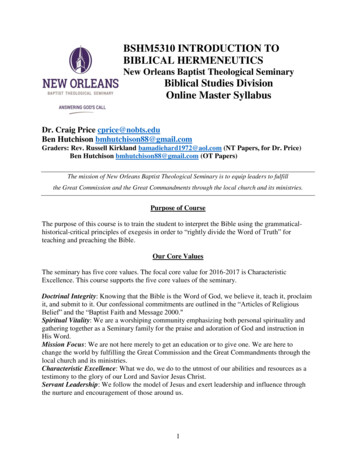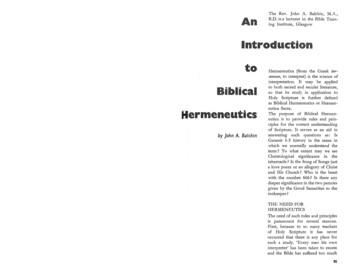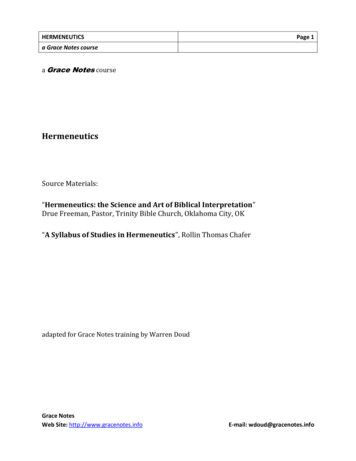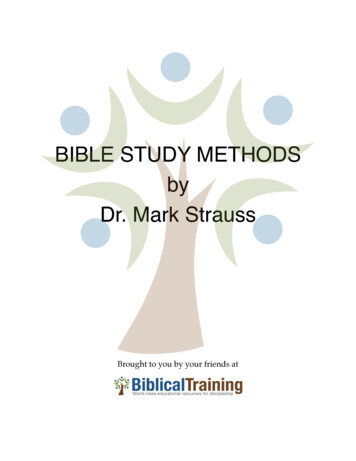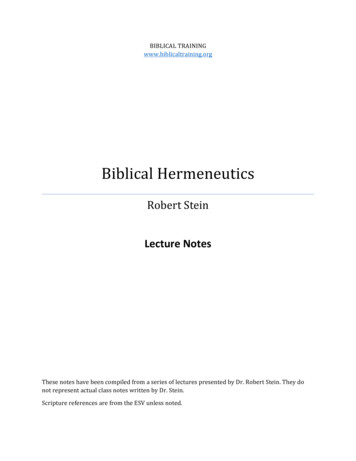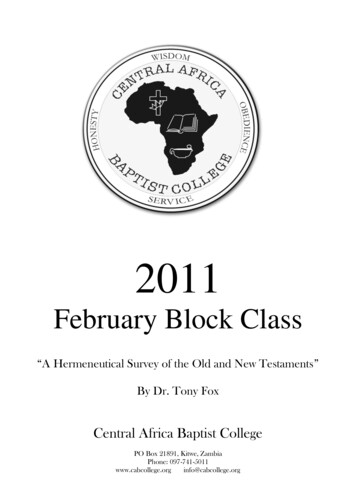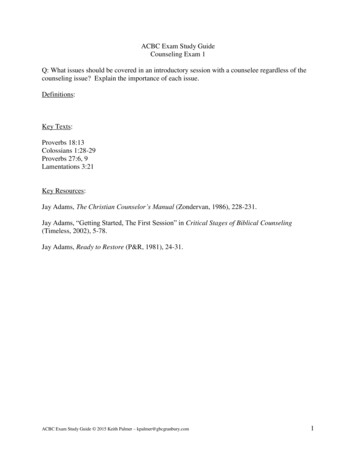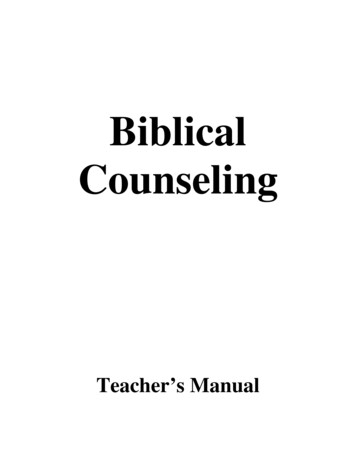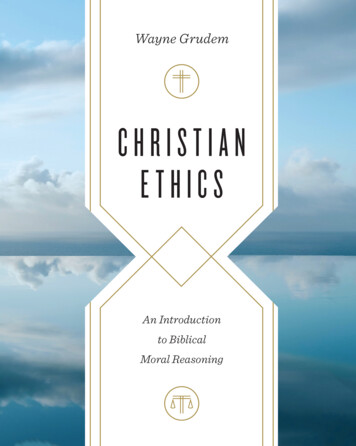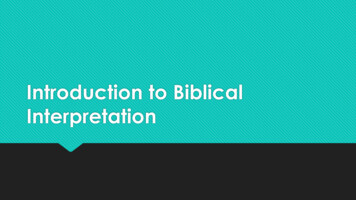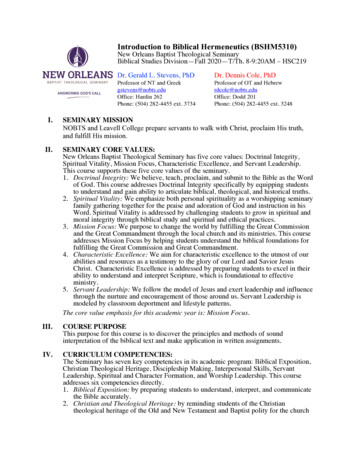
Transcription
Introduction to Biblical Hermeneutics (BSHM5310)New Orleans Baptist Theological SeminaryBiblical Studies Division—Fall 2020—T/Th. 8-9:20AM – HSC219I.II.Dr. Gerald L. Stevens, PhDDr. Dennis Cole, PhDProfessor of NT and Greekgstevens@nobts.eduOffice: Hardin 262Phone: (504) 282-4455 ext. 3734Professor of OT and Hebrewrdcole@nobts.eduOffice: Dodd 201Phone: (504) 282-4455 ext. 3248SEMINARY MISSIONNOBTS and Leavell College prepare servants to walk with Christ, proclaim His truth,and fulfill His mission.SEMINARY CORE VALUES:New Orleans Baptist Theological Seminary has five core values: Doctrinal Integrity,Spiritual Vitality, Mission Focus, Characteristic Excellence, and Servant Leadership.This course supports these five core values of the seminary.1. Doctrinal Integrity: We believe, teach, proclaim, and submit to the Bible as the Wordof God. This course addresses Doctrinal Integrity specifically by equipping studentsto understand and gain ability to articulate biblical, theological, and historical truths.2. Spiritual Vitality: We emphasize both personal spirituality as a worshipping seminaryfamily gathering together for the praise and adoration of God and instruction in hisWord. Spiritual Vitality is addressed by challenging students to grow in spiritual andmoral integrity through biblical study and spiritual and ethical practices.3. Mission Focus: We purpose to change the world by fulfilling the Great Commissionand the Great Commandment through the local church and its ministries. This courseaddresses Mission Focus by helping students understand the biblical foundations forfulfilling the Great Commission and Great Commandment.4. Characteristic Excellence: We aim for characteristic excellence to the utmost of ourabilities and resources as a testimony to the glory of our Lord and Savior JesusChrist. Characteristic Excellence is addressed by preparing students to excel in theirability to understand and interpret Scripture, which is foundational to effectiveministry.5. Servant Leadership: We follow the model of Jesus and exert leadership and influencethrough the nurture and encouragement of those around us. Servant Leadership ismodeled by classroom deportment and lifestyle patterns.The core value emphasis for this academic year is: Mission Focus.III.COURSE PURPOSEThis purpose for this course is to discover the principles and methods of soundinterpretation of the biblical text and make application in written assignments.IV.CURRICULUM COMPETENCIES:The Seminary has seven key competencies in its academic program: Biblical Exposition,Christian Theological Heritage, Discipleship Making, Interpersonal Skills, ServantLeadership, Spiritual and Character Formation, and Worship Leadership. This courseaddresses six competencies directly.1. Biblical Exposition: by preparing students to understand, interpret, and communicatethe Bible accurately.2. Christian and Theological Heritage: by reminding students of the Christiantheological heritage of the Old and New Testament and Baptist polity for the church
Hermeneutics, Fall 2020, Stevens/Cole23. Discipleship Making: by stimulating church health through mobilizing the church formissions, evangelism, discipleship, and church growth through modeling theprinciples of discipleship through classroom deportment.4. Interpersonal Skills: by performing pastoral care effectively with skills incommunication and conflict management through interaction among students in theclass and in small group activities.5. Servant Leadership: by serving churches effectively in team ministry throughmodeling and reflecting the attitude of Christ in the life of a disciple.6. Spiritual and Character Formation: by providing moral leadership and modeling andmentoring Christian character and devotion through discussion and modeling ofspiritual disciplines as a normal part of class discussion and activity.V.COURSE DESCRIPTION:This course is a study of the principles of biblical interpretation, an introduction to themajor resources available for biblical interpretation, and an exegetical study of selectedpassages from the various types of biblical literature. The major focus of the course ispractical—the course goal is that the student would develop sound methods of exegesisand application of biblical texts.VI.STUDENT LEARNING OUTCOMES:KnowledgeStudents who complete this course successfully should: Understand the significance of hermeneutics for biblical exposition Know the basic methods of biblical interpretation that have been practiced throughouthistory Know basic principles of grammatical-historical interpretation that lead interpretersto discover the meaning intended by the biblical author Know the major genres of scripture and the hermeneutical principles that should beapplied to each genre Know the important tools that may be useful in the study of the biblical text Know principles that guide modern preachers and teachers in applying biblical truthsto our contemporary contextAttitudesStudents who complete this course successfully should: Appreciate the complexities of the exegetical task Recognize the importance of sound exegesis Be more confident in interpreting biblical textsSkillsStudents who complete this course successfully should be able to: Contextualize New Testament texts within their ancient historical, cultural, social,and literary settings for the purpose of interpretation Prepare word studies that lead the interpreter to understand better the biblical author’susage of special vocabulary significant to the exegetical task Write a formal paper using required form and style guidelines that integrates learningactivities of the course into the sound exegesis of an assigned passage Derive timeless truths from the biblical text and show how these should affect thebeliefs and behavior of contemporary ChristiansVII.TEACHING METHODLOGY: Class sessions will consist of presentations overviewing units of study followed bygeneral discussion. Readings and lectures are central to covering the knowledge baseneeded for the course. Small group discussions allow for student interaction with thematerial presented. Multimedia technology, including video, audio, graphics, and
Hermeneutics, Fall 2020, Stevens/Cole 3presentation media, are incorporated into classroom activity to enhance the learningprocess. Biblical texts are used as examples to illustrate hermeneutical principlesdiscussed in class. The combination of readings, lectures, multimedia, classdiscussions, and small groups should help build appreciation for sound exegesis ofthe Bible.Class preparation will consist of textbook readings according to the syllabusschedule, book reports, and execution of written assignments. That is, the student’sskills as an exegete are developed further through written assignments related to wordstudies, background studies, and an exegetical paper.Class units presented are: five units on hermeneutical models, two units on generalrules with library practicum, and fifteen units on genre specific principles.VIII. TEXTBOOKS:A. Required The Bible: any modern committee translation, such as RSV, NRSV, NIV, NASB,etc. Fee, Gordon D. and Douglas Stuart. How to Read the Bible for All Its Worth, 4thed. Grand Rapids: Zondervan, 2014 ( FS) Klein, Blomberg, and Hubbard. Introduction to Biblical Hermeneutics, 3d ed.Grand Rapids: Zondervan, 2017 ( KBH)B. Optional Bray, Gerald. Biblical Interpretation: Past and Present, Intervarsity Press, 2000( GB) Porter, Stanley and Beth Stovall. Biblical Hermeneutics: 5 Views, IntervarsityPress, 2012 ( P&S)IX.OTHER RESOURCES: Dr. Stevens’s DrKoine Website:http://www.drkoine.com This website is for students in classes taught by Dr. Stevens. The site has a three-foldpurpose: (1) to provide personal information to get to know the professor beyond theclassroom in the areas of background, family, music and photography, (2) to provideprofessional information to get to know the professor within the academic guild in theareas of publications, presentations, and sermons, and (3) to provide educationalinformation in support of his teaching career in the areas of classes, travel, andmuseums.To go straight to the Classes page for information about any of Dr. Stevens’s classes,use the following link:http://drkoine.com/classes/index.html To go straight to the Hermeneutics course page with a brief course description,introductory video, syllabus, textbooks used, and related course files, use this .html For NOBTS assistance with technology issues, call ITC (504-816-8180) or consultthe following websites.—For online registration, financial account, online transcript. etc.:selfserve.nobts.edu (email: selfserve@nobts.edu)—For Blackboard Learning Management system:
Hermeneutics, Fall 2020, Stevens/Cole X.4nobts.blackboard.com (email: blackboardhelpdesk@nobts.edu)—For general technical questions and support requests:www.nobts.edu/itc/ (email: itcsupport@nobts.edu)For help in writing papers, NOBTS maintains a Writing Center called “The WriteStuff” (HSC 290B, x8193) to improve English writing at the graduate level. Studentscan receive writing guides, tips, and valuable information towards becoming a betterwriter. Email writingcenter@nobts.eduCOURSE REQUIREMENTS and EVALUATION:1. Reading Quizzes (15%): Students are to read the portions of the required texts bythe date specified in the course schedule. These quizzes are given in class.2. Background Study (20%): The historical-critical/grammatical view begins with areview of the historical background of the book being studied. The student willcompile a background study about the historical and cultural context for an assignedpassage. Single-spaced, Turabian format, 4-6 pages excluding cover page andbibliography. Please use a minimum of 5-6 sources on this paper. The historicalbackground study will include the following:a. background information on your assigned passageb. information on the setting, authorship, readership, date and place of writing ofthe letter, etc.c. information on the critical issues of the passaged. a discussion of the theological issues covered in the passage. Outside sources(such as Bible commentaries, dictionaries, encyclopedias, or histories) should beused here.e. a section where you focus upon your specific background topic as indicated inthe Bible passages below. (See further in this syllabus.)3. Word Study (20%): The historical-critical/grammatical view gives focus to wordstudies and what words meant in the original context. The student will complete aword study on a word indicated from an assigned text (see the list in this syllabusbelow). The paper is to be single-spaced, Turabian format, 2-3 pages excluding thecover page and bibliography. Please use a minimum of 5-6 sources on this paper.4. Project (45% total for two stages): Using the historical-critical/grammaticalmethod of exegesis, the student will exegete the selected passage. The major projectin the course is consists of a practical application in the form of an exegetical paper,which is to be produced in two stages. The detailed instructions are located at theend of the syllabus. (See below.)a. Stage One (30%): STAGE ONE IS THE EMBEDDED ASSIGNMENT. Thefirst stage is a thorough exegetical study that will be 10-12 pages in length(excluding the cover page and bibliography), single-spaced, Turabian format. Atthe end of this stage, the student should have gathered all the essential knowledgefrom the text and be ready to begin the task of constructing a sermon or ateaching lesson. Please use a minimum of 7-8 sources on this paper.b. Stage Two (15%): The second stage is a polished, written paper, 5-6 pagesexcluding the cover page and bibliography, Turabian format, single-spaced whichpresents the information gathered in the first stage in ready-to-deliver form. Thepurpose of this stage is to synthesize the data you have gathered in the first twostages into a well-written presentation. The paper may take one of three forms:(1) a sermon manuscript, i.e., written out word-for-word, ready to deliver orally,or (2) a teaching plan, fully developed and ready for teaching purposes, or (3) amanuscript for submission for publication. Please use a minimum of 5-6 sourceson this paper.
Hermeneutics, Fall 2020, Stevens/Cole5This paper should have an interesting introduction, developed body, and aconclusion that ties the paper together. Thus, this stage contrasts in presentationwith the first stage, in that the first stage is merely a step-by-step distillation ofyour findings, whereas the second stage is a finished and polished work. Be sureto consider your audience when choosing the format of the paper and in shapingthe material for presentation. More detailed instructions for this stage are also tobe found attached.5. Extra Credit: Up to 3 points added to the student’s final average can be earned bydoing an extra credit project.a. Book Review (up to 3 points added to the student’s overall final grade): Thestudent may present a 6 page, single-spaced book review where the student isawarded 1 point per 150 pages read. The book must be germane to the study ofhermeneutics and approved by the professors.b. Short Research Paper (up to 3 points added to the student’s overall final grade):The student may prepare a research paper on a hermeneutical topic approved bythe professors. The paper must be at least 6 pages, single-spaced, cite at least 10sources, and be germane to the study of biblical interpretation.6. Due Date Policy: Every assignment that you have for this course is listed with anassignment due date. You are expected to have your work submitted on time. A five(5) point deduction per day will be assessed for late work. The only exceptions tothis policy will be extreme circumstances and the professor reserves the right todetermine exceptions. Procrastination is not considered an extreme circumstance, ora valid exception.7. Embedded Assignment: This core course incorporates an embedded assignment forthe purposes of assessing institutional effectiveness and for program evaluation. Theembedded assignment is stage one of the research project. The embeddedassignment description and grading rubric follows.a. Paper. Write a polished, 10-12 page paper. The student should have gathered allthe essential knowledge from the text and be ready to begin the task ofconstructing a sermon or a teaching lesson.b. Exegetical Principles. Indicate the use of appropriate tools, methods, andresources in the application of sound exegetical principles.c. Contemporary Application. Communicate the meaning of the text, keeping inmind the contemporary audience.d. Format. The paper may take two forms: 1) a ready to deliver, word-for-word,sermon manuscript; 2) a teaching article, such as an article for BiblicalIllustrator.e. Rubric. The general grading rubric to be used in evaluating the embeddedassignment performance of students in the class is outlined in the table below.DomainUnderstandingThe student:ApplicationThe student:CommunicationThe student:LevelUnderstood the principles forguiding the exegetical processUsed appropriate tools to apply sound exegeticalprinciples in biblicalinterpretationCommunicate clearly themeaning of the Biblical textin a written manner that isunderstandable to acontemporary/modernaudienceInadequate(0 points)Basic(1 point)Competent(2 points)Good(3 points)Excellent(4 points)
Hermeneutics, Fall 2020, Stevens/Cole8. Final Average:Reading quizzes Background study Word study Project stage one Project stage two -615%20%20%30%15%XI. ATTENDANCE and ETIQUETTEAttendance: Only six (6) absences are allowed to receive course credit. Punctualassignments, threaded discussion participation, timely tests, and other factors countfor class attendance.XII. PLAGIARISM, HONESTY AND INTEGRITY Plagiarism: NOBTS has a no tolerance policy for plagiarism. Plagiarism in certaincases may result in expulsion from the seminary. See the NOBTS Student Handbookfor definition, penalties, and policies associated with plagiarism. Honesty and Integrity: An Internet course by default puts almost all accountabilityand responsibility on the student. In this environment, NOBTS students are expectedto exemplify the highest levels of honesty of work and integrity of character in theperformance of assignments for this class. Unless specifically indicated otherwise,all online quizzes and exams are closed-book and the use of any memory aids of anykind whatsoever is expressly forbidden. All work is expected to be the student’sown.XIII. NOBTS Style Guide:Writing assignments should follow the NOBTS/Leavell College Manual of Form andStyle (revised August 2019). To access this manual on the seminary website, go tohttps://www.nobts.edu/ resources/pdf/writing/StyleGuide.pdf. The NOBTS Style Guidecan also be found in the course Blackboard shell.XIV. ASSIGNMENTS:WEEKWeek 1:Aug 25, 27Week 2:Sept 1, 3Week 3:Sept 8, 10Week 4:Sept 15, 17Week 5:Sept 22, 24Week 6:Sept 29,Oct 1Week 7Oct 6, 8Week 8Oct 13, 15TuesdayIntroduction, Model Components FS: 21-35; KBH: 39–65Ancient Christian Models KBH: 77–91Canon, Translations, Tools FS: 36-56; 275-90 KBH: 165–97; 637–81Interpreter, Goal, Application KBH: 201–290; 571–636ThursdayAncient Jewish Models KBH: 66–77Reformation, Post-Reformation KBH: 92–98Modern, Post-Modern Models KBH: 99–164 Library PracticumGeneral Rules—Prose KBH: 293–360General Rules—Poetry KBH: 361–413Interpreting OT Narrative 1 FS: 93-111Interpreting OT Narrative 2 KBH: 417–38Interpreting the Gospels 1 FS: 132-53Interpreting the Gospels 2 KBH: 510–32Interpreting Acts FS: 112-31; KBH: 532–41Due: Background StudyInterpreting the Parables FS: 154-67
Hermeneutics, Fall 2020, Stevens/ColeBreakOct 19–23Week 9Oct 27, 29Interpreting Epistles 1 FS: 74-92Week 10Nov 3, 5Interpreting Law 1 FS: 168-86Fall BreakWeek 11Nov 10, 11Interpreting Prophets 1 FS: 187-211Week 12Nov 17, 19Interpreting Apocalyptic 1 FS: 258-73BreakNov 23–27Week 13Dec 1, 3Interpreting Psalms 1 FS: 212-32Week 14Dec 8, 10Interpreting Wisdom 1 FS: 233-57Week 15Dec 15–177Interpreting Epistles 2 KBH: 541–58Interpreting Law 2 KBH: 438–50Due: Word StudyInterpreting Prophets 2 KBH: 462–91Interpreting Apocalyptic 2 KBH: 491–93; 558–67Due: Stage 1 PaperThanksgiving BreakInterpreting Psalms 1 KBH: 451–61Interpreting Wisdom 2 KBH: 493–509Due Stage 2 PaperFINAL EXAMS and GRADUATIONXIV. EXEGETICAL PROJECT TOPICS: Select ONESelect one (1) of the following passages that you will use for all of your written exercisesin this course. Note that your word study topic and background topic have beenpreselected for you related to each specific passage. Your background paper topic, inaddition to general background, also should include the specific background of yourpassage.Background Study – Due Thursday, Oct. 15Word Study – Due Thursday, Nov. 5Old TestamentNarrativeRuth 3:1–18Word Study Paper Topic: “Kinsman Redeemer,” goel (v. 28)Background Paper Focus: Levirate MarriageLawExod. 19:1–8Word Study Paper Topic: “Covenant,” berith (v. 5)Background Paper Focus: Covenants in the OTPoetryPsalm 18:1–19Word Study Paper Topic: “Sheol,” sheol (v. 5 )Background Paper Focus: Salvation in the OTWisdomProv. 3:13–18Word Study Paper Topic: “Wisdom,” chomah (v. 13)Background Paper Focus: Tree of Life in the OTProphecyEzek. 37:1–14Word Study Paper Topic: “Spirit, spirit, wind, breath,” ruach (v. 1, 6, 9)
Hermeneutics, Fall 2020, Stevens/Cole8Background Paper Focus: Resurrection in the OTNew TestamentNarrative- GospelsMatt. 26:17–30Word Study Paper Topic: Covenant, diatheœkeœ (v. 28)Background Paper Focus: Passover Feast of the JewsNarrative- ParablesLuke 20:9–19Word Study Paper Topic: Parable, paraboleœ (v. 1)Background Paper Focus: Tenant Farmers/Rich and PoorNarrative- HistoryActs 8:4–25Word Study Paper Topic: To Baptize, baptizoœ (v. 12)Background Paper Focus: Samaritan-Jewish Relations in the First CenturyEpistle1 Tim. 2:8–15Word Study Paper Topic: Silence, sigaoœ (to keep silent), heœsychia (silence) (v. 11)Background Paper Focus: Role of Women in the ancient Near EastEpistle1 Corinthians 7Word Study Paper Topic: Divorce, apolyoœ (to set free), apostasion (divorce)Background Paper Focus: MarriageApocalypticRev. 7:9–17Word Study Paper Topic: Great Tribulation, thlipsis megas (v. 14)Background Paper Focus: Palm BranchesXV.EXEGETICAL PROJECT GUIDELINESA. Stage One – Due Thursday, Nov. 19This paper assignment contains the primary steps to be taken in a thorough exegesis of abiblical passage. When the assignment is completed, you should be ready to add thehomiletical components of sermon preparation and then to preach the sermon. The papermust follow the following steps, in order.In your paper outline, use the headings given below and then do the work specified.This paper is not a typical term paper in the sense of having an ordered introduction,statement of purpose, development of thought, and conclusion. These elements are notneeded. Instead, begin on the first page with the “Text” section and proceed through thepaper according to the outline below. The final product will be a collection of theseparate sections below, but they are all ordered in a logical sequence that should help insermon preparation. (For more instructions on the mechanics of producing the paper, seethe last page.)In doing this in-depth exercise, you should learn the essential steps for a properexegesis. At first, the work seems daunting for the time constraints of practical ministryweek by week. However, as with developing all skill sets, the more you work thisprocess, the easier you will find the journey, and good skills of exegesis will becomesecond nature.1. Text. Write out the text of the passage chosen, single-spaced, including versenumbers and indications of your own paragraph divisions, from one of the following
Hermeneutics, Fall 2020, Stevens/Cole9translations: TNKH, KJV, NKJV, ASV, NASB, RSV, NRSV, NIV, NJPSV, REB,RAB, NLT. (1/2–1 page)2. Historical Background. This section should be a summarized presentation of yourprevious background study. Use your research from your background paper to writethis section.Focus on information not directly gathered from the text itself or its literarycontexts (i.e., matters such as dates, international situation, etc.). Include here themajor results of your sample historical background study. (That is, summarize yourbackground study results; do not just cut and paste your background study in whole.)Also remember that you will need to do more general background study for the largerproject, as well as other specific historical, cultural topical studies. Outside sources(such as Bible commentaries, dictionaries, encyclopedias, or histories) should be usedhere. (1–1.5 pages)3. Literary Context. (1) Discuss the placement of the passage in its immediate andlarger contexts within the book, and (2) justify the paragraph divisions you haveprovided above. Look for clues in the immediately preceding and following contexts(the surrounding paragraphs and chapters) that show how the passage you areconsidering fits into its context. (1 page)4. Paragraph Analysis. Identify the theme of each paragraph in one sentence perparagraph. The theme may be a key sentence taken directly from the text or astatement in your own words. Justify your judgment for each theme statement (i.e.,give your reasons for your choices). (1 page)5. Verse Analysis. Comment here on important features of individual verses. (In alonger passage, focus on each paragraph instead of each verse.) Do not merelysummarize each verse (or paragraph) or re-state the obvious. Do comment on theflow of the argument or storyline from verse to verse (or paragraph to paragraph),including addressing why certain thoughts may be stated in a particular way, whycertain statements are included where they are, why omissions of expected materialsoccur, etc. Comment as needed on important theological words or ideas. Noticewhere else in the book or in other biblical books certain words or ideas are found.You may use concordances or theological wordbooks here, including any crossreferencing guide you like (such as that found within most Bibles themselves), but,you may not use a commentary here. Do your own work here. (2–3 pages)6. Theme. Based upon the various stages of your detailed analysis above, and especiallybuilding upon your statements of theme for each paragraph, provide a one-sentencestatement of the theme of the entire text. (What is the author’s main point in thistext?) Explain the basis for your decision. (1/2 page)7. Word Study. Include here the major results (summary) of your sample word study(not the raw data you presented earlier). Also remember that you probably will needto do other word studies for this larger project. (1 page)8. Outline. Present an “exegetical” (“historical”) outline of the text, reflecting thetheme. Use past tense verbs in your outline. (1/3–1/2 page)9. Homiletical (Sermon or Teaching) Outline. This outline should derive from theexegetical outline. Use present tense verbs in your outline in order to contemporizethe ideas. Include a one-sentence restatement of the theme (point “6” above), adesired audience response, and a concluding challenge. (1/2 page)10. Commentary Comparison. Include here any additional essential insights gleanedfrom three exegetical commentaries. These must be insights that you did not alreadyuncover in your own work. You may include these insights into the body of yourwork in Stage Two of your paper, but here, be sure to do the work asked for in theorder requested. (1 page)Note 1: The use of commentaries is to be limited to the specific instructions for theproject; the only two points at which you are to use them are (1) in the Historical
Hermeneutics, Fall 2020, Stevens/Cole10Background step and (2) in Step 10 of Stage One. The reason for this restriction is tohelp you to see how commentaries can be most helpful to you in your work, ratherthan becoming an unhealthy crutch and a hindrance to developing your own spiritualinsight.Note 2: Page numbers listed in parentheses after each section of the project indicatetypical length of that section; these page numbers are suggested guides only. Themajor concern is that you accomplish the required work. However, the final productshould be no less than ten (10) and no more than twelve (12) pages, single-spaced.B. Stage Two – Due Thursday, Dec. 10Stage Two of the project is a polished paper presenting the information gathered in thefirst stage in ready-to-deliver form. The purpose of this stage is to synthesize the data youhave gathered in the first stage into a well-written presentation. The well-writtenpresentation should take one (1) of the following two forms:1. Sermon Manuscript. This manuscript should be written out word-for-word, ready todeliver orally.2. Teaching Plan. This manuscript should be a complete teaching plan, fully developed,and represent good teaching methodology and practice.Whether a sermon manuscript or a teaching plan, Stage Two of the project should havean interesting introduction, a developed body, and a conclusion that ties the papertogether. Thus, this stage contrasts with the first stage in that the first stage is merely astep-by-step distillation of your findings. The second stage is a finished and polishedwork. Be sure to consider your audience in choosing the format of the paper and inshaping the material for presentation. (5-6 pages, single-spaced, 5-6 sources minimum)Style and Formatting Guidelines for PapersThe papers are to be neatly typed, single-spaced, using 12-point font. All formattingshould follow fully Kate L. Turabian, A Manual for Writers. Page numbers shouldmaintain a difference between the first page number of a chapter (bottom center) and allfollowing page numbers of that chapter (at top, with right margin preferred). AnyTurabian approved scheme of footnotes, end notes, or text notes is acceptable; but mustbe used consistently (do not mix schemes in the same paper). The paper should include afull bibliography of sources consulted. Complete and proper documentation must beprovided for all sources used as specified by Turabian. Entries should be by author andtitle of book, commentary, or article (not editor!), with series name and editor appearingat the appropriate place.Standard academic writing procedures must be followed, including writing in yourown words, giving proper credit when quoting or referring to material from anotherwork, and writing in good English. Students who may have trouble with writing ofEnglish are expected to have their papers proofread by someone conversant in Englishwriting skills prior to production of the papers. Note the help available with the NOBTS“Write Stuff” center in Section “IX. OTHER RESOURCES” above.Plagiarism on Written AssignmentsNOBTS has a no tolerance policy for plagiarism. Plagiarism in certain cases may result inexpulsion from the seminary. If the student is not aware of the seminary policy or whatconstitutes plagiarism, he or she should contact the Dean of Student’s Office for
Hermeneutics, Fall 2020, Stevens/Cole11information on how to obtain a copy of the NOBTS Student Handbook. The StudentHandbook clearly defines plagiarism and the associated policies and penalties.Recommended Computer SoftwareThe student is encouraged to purchase Bible software for use in biblical exegesis. At thislevel of study, a software program capable of producing the text, performingsophisticated morphological searches, with available lexicons, commentaries, and otherhelpful supplemental works is crucial. The software packages listed below are capable ofintense, complex searches required for biblical studies research purposes and/or sermonpreparation. The purchase of this kind of software is indispensable at this level oflanguage study. The major software packages all run on either PC or Mac platforms.1. Accordance
Introduction to Biblical Hermeneutics (BSHM5310) New Orleans Baptist Theological Seminary Biblical Studies Division—Fall 2020—T/Th. 8-9:20AM – HSC219 . This course is a study of the principles of biblical interpretation, an introduction to the major resources available for biblical interpr
